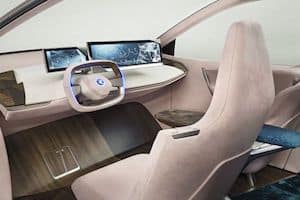Steering Wheels Communicate Multi-Dimensional Information
Steering wheels communicate multi-dimensional information: Signal new era of automated driving
By: Tim Spell
Steering wheels that deliver information to the driver via haptic, tactile or visual feedback are key components of new-breed automated vehicles. Several luxury electric-car manufacturers are either offering or have announced the development of “smart” steering wheels.
Haptic technology, which stimulates the senses of touch and motion to convey information, are commonly used in the form of vibration or correcting handwheel torque to keep a vehicle in its lane. A more-advanced application of the technology is being showcased on the all-electric 2020 Karma Revero GTS luxury-performance car. It features a steering wheel rimmed with a smooth, flat surface embedded with “buttons” that control functions such as cruise control, lane-departure warning or audio volume.
Differentiation between functions is communicated to the driver “not just by haptic feedback, but also by 3D haptic feedback,” says J. Joost De Vries, Karma Automotive vice president, global sales and customer experience, noting that it’s “really a trick” that has to be experienced to be understood.
“When you put your fingers on that flat surface you feel haptic feedback of where you are, but it’s also 3D,” says De Vries. “You feel like you have depth in the motion of what you’re doing.”
BMW has developed a polygonal-shaped steering wheel for its “highly autonomous” all-electric iNEXT. BMW says its “technology flagship,” set for production in 2021, is fitted with the unusual-shaped steering to provide an advantage when switching from autonomous to active driving.

“As compared to a circular shape, this makes it much easier to recognize the steering angle based on the position of the steering wheel,” BMW reports. “The moment the driver re-takes control of the vehicle, they can detect the current steering angle instantly – both visually and by means of touch.”
The steering wheel communicates the availability of automated features via colored signals produced by optical fibers integrated into the grip’s sides.
Enhanced ergonomics is another advantage of the iNEXT’s polygonal steering wheel. Similar to the flat-bottomed steering wheels of racecars that inspired its design, it facilitates entry and exit, and increases freedom of leg movement during long-distant drives.
Tesla has submitted a patent for a steering wheel with intuitive gesture controls that incorporate features such as pinching and squeezing, which are used on smartphones, reports teslarati.com. The idea behind a user-friendly design is to increase safety and operation efficiency.
User input is via two small touchpads, integrated at either side of the steering wheel. Driver communication with the vehicle also is in the forms of haptic, visual and audible feedback.
“Haptic feedback would be signaled through a `slide vibration,’ while visual feedback would come in the form of dimmed lights on the touchpads,” reports teslarati.com. “Sound feedback would also be present on driver-initiated actions.”
Tesla’s new steering wheel design also may eliminate the conventional gear stalk. “The user interface of the steering wheel may additionally include indicators provided at a lower portion of the steering wheel indicative of a selected gear engagement of the vehicle,” states Tesla’s patent. “For example, the user interface may provide illuminated indications of engagement of Park, Reverse, Neutral or Drive modes.”
Engineers under the direction of Stanford University professor Mark Cutkosky have developed an intuitive haptic feedback system that communicates multi-dimensional information through the steering wheel grip. This technology is seamlessly integrated into the steering wheel rim’s front portion.
“This new technology offers an alternative that acts by applying small shear forces to stretch the skin on the driver’s hand, which thereby communicates rich analog cues, including magnitude and direction information,” reports Stanford Engineering. “The system provides a tactile signal regardless of the driver’s hand position and does not affect the steering control.”
Skin stretches 2.5 millimeters in a grip region consisting of the upper thumb and the thumb’s base, down across the palm. A study found that “drivers could easily navigate an unknown course using only skin-stretch cues, and that skin-stretch cues were better than auditory cues in the presence of a distraction task simulating a phone call.”
This technology is programmable and has the potential to be used for navigation, semiautonomous vehicle intention notifications, and to enhance safety awareness for collision avoidance, lane keeping, blind-spot detection and low-traction warning.
Cruise Automation, a General Motors subsidiary, is pushing toward eliminating the role of the active driver and ridding of the steering wheel, as well as the pedals and manual controls. The all-electric Cruise AV, introduced in 2018, was GM’s first production-ready fully autonomous car. Recently, GM unveiled the Cruise Origin, a minivan-like electric-powered shuttle, absent a steering wheel, which is set for production in early 2022. The pure-autonomous Cruise vehicles are designed for commercial ride sharing and won’t be available to the average consumer.
The Cruise Origin is hailed with a smartphone and upcoming stops communicated via onboard flat screens. Lack of a steering wheel makes it impossible for Cruise vehicles to have a backup driver, which is required by federal government regulations. GM has requested an exemption to the Federal Motor Vehicle Safety Standards, which has yet to be approved.
Karma Revero GTS photo courtesy of Karma Automotive
BMW iNEXT photo courtesy of BMW
